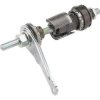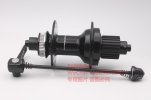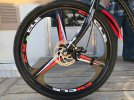YetiWoodz
Well-Known Member
(At the bottom are links to the wheels)
Other than the engine, the rear wheel of your motorized bike is the most crucial piece. All of the engine's power is applied to the rear wheel. It can be full of failures, be a serious safety hazard, and a big money pit if you get stuck with the wrong one(s).
I put this post together from mine and others' experiences.
The hub of a wheel is the center. The mechanism. Its the source of the most problems.
Lets go over what hubs are not recommended or have the potential to be unsafe.
COASTER BRAKE HUB:
Image
-Not Recommended. Found on cruiser bicycles. This hub design is not capable to withstand braking from high speeds along with the weight accompanied by an engine. The bearing cages will break, the brake arm will no longer lock in place, and the wheel will start wobbling and will soon seize to rotate. I personally went through four of these all different brands and qualities too.
QUICK RELEASE AXLES:
Image
- Found on freehub mountain bike wheels (not to be confused with freewheel). Some people had problems with the skewer snapping if its really tight then hit a pothole or something harsh. Another problem was the wheel disconnecting due to the quick release not being tight enough. Not recommended
MOTOR SPROCKET ADAPTERS
CNC HUB ADAPTER:
The cnc hub adapter will damage your wheel if its not modified.
- Will slip even if you rough up the contact points and tighten it as tight as possible.
Modification - Pinning it to the hub
Get a roll pin. A roll pin needs to compress a bit to work effectively. You won't need more than a 1/2" of pin, 1/4" in both sides. Drill a hole in the adapter and a slightly smaller hold in the hub. Put the pin in the adaptor hole and inline with the hub hole. The pin gets pressed in as you clamp it down. As long as the pin clears the axle it will work.
- Chainlube & StreetRyderz successfully done this and recommended it.
RAG JOINT:
The rag joint is debateable. It usually works fine if installed correctly and if its on a strong wheel. Not recommended on heavily modified/fast motorbikes.
- Clamped on only to one side of the wheel which equals half the spokes. Too much stress on those spokes may pull the rim to that side over time or even snap them off if you got inadequate spokes or incorrect spoke tension.
Modification - Dual Rag Joint
You can install a rag joint on both sides and connect them as one adapter with long bolts running through them. Will be very frustrating to install but it requires no modification to the wheel itself.
AXLES:
- Bolt on/thru axles are best. They are the strongest type of axle as they are solid.
SPOKES:
- You want steel, stainless steel, or alloy steel construction for strength. Spokes must generally be 12 gauge or larger (smaller # is larger) when paired with a single wall rim. Spokes may be 14 gauge or larger when paired with a double wall rim since they're much stronger. Depending on spoke quality, a 14 gauge may be just as strong or stronger than a cheap 12 gauge. Tighten the spokes with a spoke tool if they arrive loose. Do not over tighten.
RIMS:
Rims you want to be at least 1.5" wide. This is for strength and ability to put on bigger tires. Steel, stainless steel, or alloy steel for spoked wheels.
TIRES:
1.95" and 2.125" wide are great options. More comfortable ride, grip, and better wheel protection. Make sure the tread is appropriate for your riding conditions. Keep tire pressure up with spoked wheels to help prevent bending of the rim and regular or slightly less tire pressure with mag wheels for cushion to help protect the rim from cracking when hitting potholes/bumps.
DISK BRAKE ON REAR WHEEL:
Disk brakes go on the left side of the wheel which means it needs to go next to the motor sprocket. But the disc rotor needs a spacer so the motor chain doesn't hit it. All of this changes the fork dropout spacing which means it'll be too wide to fit on certain bikes like cruisers. Some people were able to widen their fork using force but only if its a steel fork, aluminum will break before it bends like that.
BEST WHEELS TO BUY
1. The Grubee HD
Ebay.com link
Pros
- No hassle easy to install, made for motorized use.
- Freewheel
- 12 gauge spokes
- Steel
- Disk brake compatible
- Directly mount your motor sprocket to hub
Cons
- Expensive at $160
2. Bikeberry Freewheel Bikeberry.com
Pros
- $45
- easy to install
- disk brake compatible, just needs rotor adapter and you can install sprocket.
Link to rotor adapter
3. Mag Wheels Ebay.com link
Pros
- No spokes
- Disk brake compatible
- Lightweight thick aluminum construction
- need a mag adapter to attach sprocket. No modification needed. Amazon.com link
Cons
- They have a chance of cracking if you ride in an area with lots of bad potholes or if offroading and you have a high speed bike. Spokes act as a shock absorber since they flex. Mag wheels are completely rigid.
- Narrow width, can still fit 2.125" wide tires but it looks weird.
4. Freewheel Ebay.com link (freewheel in link has a 7/8" OD hub. No cnc hub adapters I've seen are made for that size).
Pros
- cheapest option
Cons
- to mount sprocket, you need the rag joint.
- not disk brake compatible
Front Wheel
- I recommend getting a disk brake wheel. You will need a disk brake compatible fork with that though unless you can weld or fab something fancy together. Non disk brake forks will bend or break sending you over your handlebars because they aren't designed to handle the braking forces of a disk brake. Triple tree forks are a great option.
- Front wheel with disk brake and rear wheel with rim brake or disk brake is a good setup.
Dual brake lever: Amazon.com link
- lets you control both front and rear brake at the same time all in one lever. Very useful since the clutch lever takes up one side.
Other than the engine, the rear wheel of your motorized bike is the most crucial piece. All of the engine's power is applied to the rear wheel. It can be full of failures, be a serious safety hazard, and a big money pit if you get stuck with the wrong one(s).
I put this post together from mine and others' experiences.
The hub of a wheel is the center. The mechanism. Its the source of the most problems.
Lets go over what hubs are not recommended or have the potential to be unsafe.
COASTER BRAKE HUB:
Image
-Not Recommended. Found on cruiser bicycles. This hub design is not capable to withstand braking from high speeds along with the weight accompanied by an engine. The bearing cages will break, the brake arm will no longer lock in place, and the wheel will start wobbling and will soon seize to rotate. I personally went through four of these all different brands and qualities too.
QUICK RELEASE AXLES:
Image
- Found on freehub mountain bike wheels (not to be confused with freewheel). Some people had problems with the skewer snapping if its really tight then hit a pothole or something harsh. Another problem was the wheel disconnecting due to the quick release not being tight enough. Not recommended
MOTOR SPROCKET ADAPTERS
CNC HUB ADAPTER:
The cnc hub adapter will damage your wheel if its not modified.
- Will slip even if you rough up the contact points and tighten it as tight as possible.
Modification - Pinning it to the hub
Get a roll pin. A roll pin needs to compress a bit to work effectively. You won't need more than a 1/2" of pin, 1/4" in both sides. Drill a hole in the adapter and a slightly smaller hold in the hub. Put the pin in the adaptor hole and inline with the hub hole. The pin gets pressed in as you clamp it down. As long as the pin clears the axle it will work.
- Chainlube & StreetRyderz successfully done this and recommended it.
RAG JOINT:
The rag joint is debateable. It usually works fine if installed correctly and if its on a strong wheel. Not recommended on heavily modified/fast motorbikes.
- Clamped on only to one side of the wheel which equals half the spokes. Too much stress on those spokes may pull the rim to that side over time or even snap them off if you got inadequate spokes or incorrect spoke tension.
Modification - Dual Rag Joint
You can install a rag joint on both sides and connect them as one adapter with long bolts running through them. Will be very frustrating to install but it requires no modification to the wheel itself.
AXLES:
- Bolt on/thru axles are best. They are the strongest type of axle as they are solid.
SPOKES:
- You want steel, stainless steel, or alloy steel construction for strength. Spokes must generally be 12 gauge or larger (smaller # is larger) when paired with a single wall rim. Spokes may be 14 gauge or larger when paired with a double wall rim since they're much stronger. Depending on spoke quality, a 14 gauge may be just as strong or stronger than a cheap 12 gauge. Tighten the spokes with a spoke tool if they arrive loose. Do not over tighten.
RIMS:
Rims you want to be at least 1.5" wide. This is for strength and ability to put on bigger tires. Steel, stainless steel, or alloy steel for spoked wheels.
TIRES:
1.95" and 2.125" wide are great options. More comfortable ride, grip, and better wheel protection. Make sure the tread is appropriate for your riding conditions. Keep tire pressure up with spoked wheels to help prevent bending of the rim and regular or slightly less tire pressure with mag wheels for cushion to help protect the rim from cracking when hitting potholes/bumps.
DISK BRAKE ON REAR WHEEL:
Disk brakes go on the left side of the wheel which means it needs to go next to the motor sprocket. But the disc rotor needs a spacer so the motor chain doesn't hit it. All of this changes the fork dropout spacing which means it'll be too wide to fit on certain bikes like cruisers. Some people were able to widen their fork using force but only if its a steel fork, aluminum will break before it bends like that.
BEST WHEELS TO BUY
1. The Grubee HD
Ebay.com link
Pros
- No hassle easy to install, made for motorized use.
- Freewheel
- 12 gauge spokes
- Steel
- Disk brake compatible
- Directly mount your motor sprocket to hub
Cons
- Expensive at $160
2. Bikeberry Freewheel Bikeberry.com
Pros
- $45
- easy to install
- disk brake compatible, just needs rotor adapter and you can install sprocket.
Link to rotor adapter
3. Mag Wheels Ebay.com link
Pros
- No spokes
- Disk brake compatible
- Lightweight thick aluminum construction
- need a mag adapter to attach sprocket. No modification needed. Amazon.com link
Cons
- They have a chance of cracking if you ride in an area with lots of bad potholes or if offroading and you have a high speed bike. Spokes act as a shock absorber since they flex. Mag wheels are completely rigid.
- Narrow width, can still fit 2.125" wide tires but it looks weird.
4. Freewheel Ebay.com link (freewheel in link has a 7/8" OD hub. No cnc hub adapters I've seen are made for that size).
Pros
- cheapest option
Cons
- to mount sprocket, you need the rag joint.
- not disk brake compatible
Front Wheel
- I recommend getting a disk brake wheel. You will need a disk brake compatible fork with that though unless you can weld or fab something fancy together. Non disk brake forks will bend or break sending you over your handlebars because they aren't designed to handle the braking forces of a disk brake. Triple tree forks are a great option.
- Front wheel with disk brake and rear wheel with rim brake or disk brake is a good setup.
Dual brake lever: Amazon.com link
- lets you control both front and rear brake at the same time all in one lever. Very useful since the clutch lever takes up one side.
Attachments
Last edited:
Links to eBay may include affiliate code. If you click on an eBay link and make a purchase, this forum may earn a small commission.
Links to Amazon may include affiliate code. If you click on an Amazon link and make a purchase, this forum may earn a small commission.



